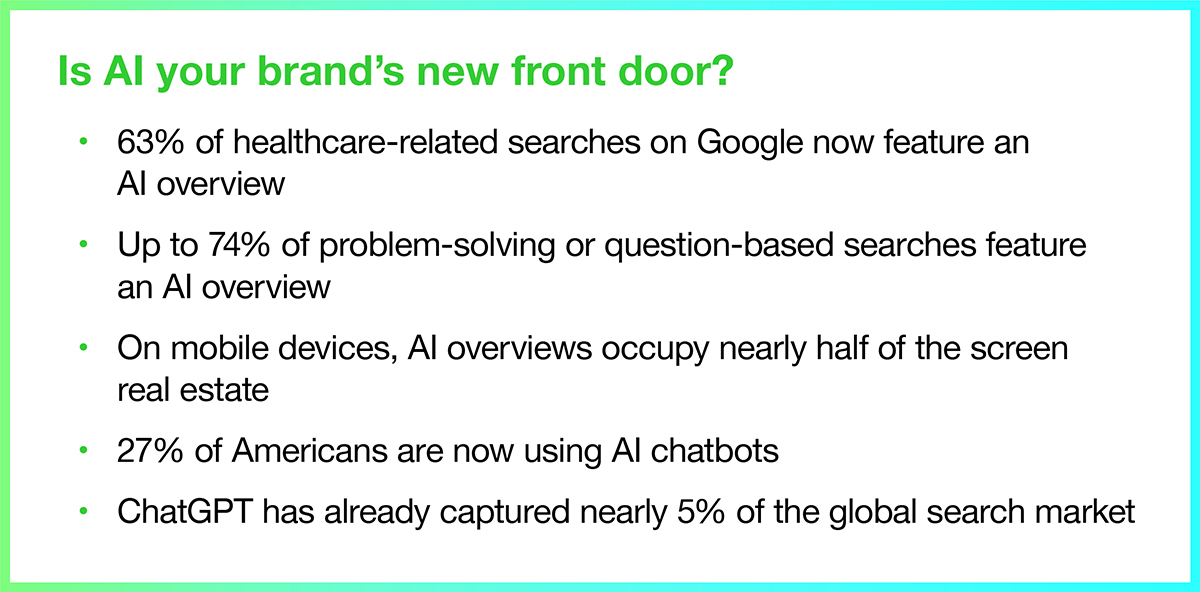Innovate
Beyond Omnichannel: Is Your Brand Ready for ALPHAchannel?

Tags:
AI, Alphachannel, Customer Experience Design, Design, Digital, Marketing and Advertising, Technology
It's the alphachannel world and we’re just living in it
In design, the Alpha Channel isn’t visible to the end user—but it shapes the outcome. It also brings clarity to complex images by controlling transparency and focus. This sounds a lot like the role that generative AI is fulfilling in the brand marketing ecosystem. Is generative AI rapidly becoming brand marketing’s alphachannel? And is your brand ready for it?
Generative AI is largely invisible to the consumer, but it’s optimizing and personalizing their experience at every touchpoint.
The product of generative AI is now the first thing you see in an increasingly large percentage of google searches, and nearly 5% of searchers have turned to ChatGPT (or its competitors) instead of Google. Siri and Alexa are also both getting in the generative AI game, with Apple introducing Apple Intelligence last July and Amazon announcing Alexa+ this February. And during a presentation of Accenture’s 2025 TechVision in February, innovation lead Adam Burden presented a strong case that brands that do not master a new ecosystem dominated by AI agents, assistants and overviews will risk customer disintermediation at the hands of these technologies.
Our big bet: alphachannel is the new omnichannel

Omnichannel marketing revolutionized how brands interact with customers, offering unified experiences across social, email, websites, and in-person touchpoints. But today, the next shift is underway.
- Generative AI has become the front door to brand communications, serving as the first point of contact and the primary interpreter of a brand’s voice.
- In an alphachannel world, consumers increasingly engage with brands through AI-powered interfaces—search engines, chatbots, voice assistants, and recommendation engines.
This shift demands a smarter, more adaptive engagement model—one where brands don’t just show up everywhere, but show up intelligently.
For brand directors, strategists, marketers, and executives, crafting an alphachannel approach may be the crucial advantage in reaching and motivating customers and creating seamless customer experiences. But how exactly do brands need to pivot to thrive in an alphachannel world, and how do you assess whether your brand is ready for this transformation? Let’s break it down.
Succeeding in the alphachannel world
- Structure branded data for AI—Ensure websites, product info, FAQs, and content are well-structured, up-to-date, and optimized for AI indexing (think schema markup, semantic HTML, clear metadata).
- Feed the right training content—For proprietary AI systems (like brand chatbots), train models on curated content that reflects brand tone, language, and values—not just raw data dumps.
- Own your knowledge graph—Actively manage your brand’s presence in public databases, directories, and search engine knowledge panels—these inform how generative AI references you.
- Establish voice guidelines for AI—Go beyond human-facing tone of voice guidelines—define how the brand should sound when filtered through AI-generated content, voice assistants, or chat interfaces.
- Monitor and course-correct—Use tools to analyze how your brand is portrayed in AI-generated summaries, search results, or third-party bots. File feedback, corrections, or publish clarifications when needed.
- Embed brand values in AI experiences—If your AI answers questions, recommends products, or interacts with customers, make sure it reflects your ethical stance, personality, and promises—not just functional accuracy.
Brands strategically shaping their narrative in the alphachannel world
Amazon (as a brand + platform)
- Optimizing product listings (titles, descriptions, Q&A) to align with LLM training data.
- Also enabling brands on its platform to auto-generate content that performs well in AI summaries.
Duolingo
- Actively building conversational AI into its brand experience.
- Gets featured prominently in language learning overviews due to strong narrative + AI use.
Notion
- Seamlessly integrated AI as a core productivity feature, not just an add-on.
- Strong brand association with “AI for work” in generated overviews.
HubSpot
- Created educational content optimized for AI consumption.
- Shows up in AI-generated B2B marketing tips and automation tools lists.
Grammarly
- Longstanding presence in writing assistant space + frequent mentions in AI comparison.
- Benefits from training data + consistent brand language across platforms.
Midjourney / Adobe Firefly
- Consistently show up in generative image tool recommendations due to strong branding + engaged community.
- Clear product positioning helps LLMs “understand” and surface them in the right contexts.
OpenAI / ChatGPT Plugins (e.g., Expedia, Instacart)
- These brands gained presence by embedding into AI platforms themselves, ensuring frequent exposure.
- This creates a feedback loop: more usage → more mentions in AI results.
The takeaway
The alphachannel era is upon us. To thrive in this rapidly emerging landscape, brands must actively shape their brand narratives for AI consumption and summarization. This means optimizing content for machine readability, training proprietary models with curated brand assets, and integrating directly with the platforms that feed generative systems. In an alphachannel world, the most successful brands aren’t just reacting—they’re programming their presence, managing their data ecosystems, and embedding themselves into the workflows of both humans and machines. It’s not just about visibility; it’s about strategic influence in a system where AI is the front door to brand discovery.
The next step? Future-proof your brand
Reach out to learn how we can help you evaluate your readiness for alphachannel marketing and build a strategy that positions you ahead of the curve.


